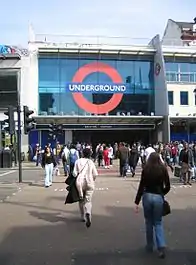Brixton tube station
Brixton is a London Underground station on Brixton Road in Brixton in the London Borough of Lambeth, South London. The station is the southern terminus of the Victoria line. The station is known to have the largest London Underground roundel on the network.[9] The next station is Stockwell.[10]
| Brixton | |
|---|---|
 Station entrance | |
 Brixton Location of Brixton in Greater London | |
| Location | Brixton |
| Local authority | Lambeth |
| Managed by | London Underground |
| Number of platforms | 2 |
| Accessible | Yes[1][2] |
| Fare zone | 2 |
| OSI | Brixton |
| London Underground annual entry and exit | |
| 2018 | |
| 2019 | |
| 2020 | |
| 2021 | |
| 2022 | |
| Key dates | |
| 23 July 1971 | Opened (Victoria line) |
| Other information | |
| External links | |
| WGS84 | 51.4626°N 0.1149°W |
History
The City and Brixton Railway had planned to link Brixton with Central London by underground railway in 1897 but was unable to raise funds for construction.
Brixton station on the Victoria line was opened on 23 July 1971 by the London Transport Executive.[11] It has high usage for an inner suburban station with 33.46 million entries and exits during 2016 making it the 19th busiest station by this measure.[12]
Design
From the ticket hall, three escalators take passengers to and from the platforms. There are also passenger lifts between street level, the ticket hall and the platforms to provide step free access.[1][2]
The station is laid out as a two-track terminus with a scissors crossover north of the station, and the line continues for a short distance south of the station platforms to form a pair of sidings.[13]
Station improvements
As part of a framework agreement with London Underground, Chetwoods were engaged to carry out an extensive refurbishment of the passenger areas of Brixton Underground Station.[14] This included an overall redesign of the station's external façade and entrance lobby, together with refurbishment of a number of smaller retail outlets and the ticket office.[14] The scheme developed the Practice's expertise in the particular technical and design requirements of underground facilities, benefitting the design approach to projects for other clients such as Network Rail.[14] The refurbishment started in 2001, and was completed in 2010. The station was briefly closed for asbestos removal in 2006. The refurbishment works were a long drawn out process.[15] New panels and lighting have been installed in the escalator shaft.[15]
Location

The station is in Brixton Road and is about 100 m[16] from Brixton railway station[10] (on the London Victoria to Orpington line, operated by South Eastern). Although the route of the London Overground South London line also runs close to Brixton tube station, there is no station in Brixton on this route because it passes overhead on high railway arches.[17][18]
Services and connections
Train frequencies vary throughout the day, but generally every 3–5 minutes between 05:55 and 00:18.[19]
London Bus routes 2, 3, 35, 37, 45, 59, 109, 118, 133, 159, 196, 250, 333, 355, 415, 432, P4 and P5,[20] and night routes N2, N3, N35, N109 and N133 serve the station.[21][22]
| Preceding station | Following station | |||
|---|---|---|---|---|
| Terminus | Victoria line | Stockwell towards Walthamstow Central | ||
References
- "Step free Tube Guide" (PDF). Transport for London. April 2021. Archived (PDF) from the original on 15 May 2021.
- "Avoiding Stairs Tube Guide" (PDF). Transport for London. December 2014. Retrieved 13 March 2015.
- "Out-of-Station Interchanges" (Microsoft Excel). Transport for London. 2 January 2016. Retrieved 28 August 2016.
- "Station Usage Data" (CSV). Usage Statistics for London Stations, 2018. Transport for London. 23 September 2020. Archived from the original on 14 January 2023. Retrieved 11 October 2023.
- "Station Usage Data" (XLSX). Usage Statistics for London Stations, 2019. Transport for London. 23 September 2020. Archived from the original on 9 November 2020. Retrieved 9 November 2020.
- "Station Usage Data" (XLSX). Usage Statistics for London Stations, 2020. Transport for London. 16 April 2021. Retrieved 1 January 2022.
- "Station Usage Data" (XLSX). Usage Statistics for London Stations, 2021. Transport for London. 12 July 2022. Retrieved 7 September 2022.
- "Station Usage Data" (XLSX). Usage Statistics for London Stations, 2022. Transport for London. 4 October 2023. Retrieved 10 October 2023.
- Laura Reynolds. "5 Things You Didn't Know About The TfL Roundel". Londonist. Retrieved 14 November 2021.
- Standard Tube Map (PDF) (Map). Not to scale. Transport for London. November 2022. Archived (PDF) from the original on 7 November 2022. Retrieved 12 November 2022.
- Butt 1995, p. 45.
- "Underground services performance". Transport for London. Retrieved 26 May 2017.
- Jarrier, Franklin. "Greater London Transport Tracks Map" (PDF) (Map). CartoMetro London Edition. 3.7. Archived (PDF) from the original on 18 November 2018.
- Brixton Underground Station Redevelopment
- "Station Refurbishment Summary" (PDF). London Underground Railway Society. July 2007. Retrieved 13 March 2015.
- Google Maps – Brixton tube station
- "East London Line Extensions – Loughborough Junction". AlwaysTouchOut. 9 November 2006. Retrieved 3 November 2007.
- "ELLG response to the South London Route Utilisation Strategy" (PDF). Network Rail. 26 October 2007. Retrieved 19 December 2012.
- "Victoria line timetable: From Brixton Underground Station to Stockwell Underground Station". Transport for London. Retrieved 13 March 2015.
- "Buses from Brixton" (PDF). Transport for London. 15 July 2017. Archived from the original (PDF) on 23 December 2018. Retrieved 23 December 2018.
- Brixton Station – Bus Archived 17 March 2015 at the Wayback Machine
- Brixton Water Lane – Bus
Bibliography
- Butt, R. V. J. (October 1995). The Directory of Railway Stations: details every public and private passenger station, halt, platform and stopping place, past and present (1st ed.). Sparkford: Patrick Stephens Ltd. ISBN 978-1-85260-508-7. OCLC 60251199. OL 11956311M.